|
.jpg)
|
The Taj Mahal is an ivory-white marble mausoleum on the south bank of the Yamuna river in the Indian city of Agra. It was commissioned in 1632 by the Mughal emperor, Shah Jahan (reigned 1628–1658), to house the tomb of his favourite wife, Mumtaz Mahal. The tomb is the centrepiece of a 17-hectare complex, which includes a mosque and a guest house, and is set in formal gardens bounded on three sides by a crenellated wall.
The Taj Mahal was designated as a UNESCO World Heritage Site in 1983 for being "the jewel of Muslim art in India and one of the universally admired masterpieces of the world's heritage".
|
|
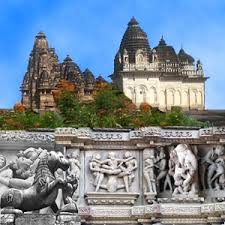
|
The Khajuraho Group of Monuments is a group of Hindu and Jain temples in Madhya Pradesh, India, about 175 kilometers (109 mi) southeast of Jhansi. They are one of the UNESCO World Heritage Sites in India. The temples are famous for their nagara-style architectural symbolism and their erotic sculptures.
Most Khajuraho temples were built between 950 and 1050 by the Chandela dynasty. Historical records note that the Khajuraho temple site had 85 temples by the 12th century, spread over 20 square kilometers. Of these, only about 25 temples have survived, spread over 6 square kilometers.
|
|
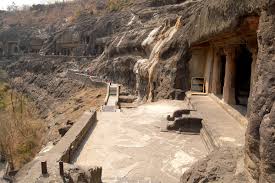
|
The Ajanta Caves in Aurangabad district of Maharashtra state of India are about 30 rock-cut Buddhist cave monuments which date from the 2nd century BCE to about 480 or 650 CE. The caves include paintings and rock cut sculptures described as among the finest surviving examples of ancient Indian art, particularly expressive paintings that present emotion through gesture, pose and form.
The caves were built in two phases, the first group starting around the 2nd century BC, while the second group of caves built around 400–650 CE according to older accounts. The site is a protected monument in the care of the Archaeological Survey of India.
|
|
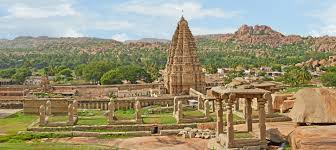
|
Hampi (Hampe) is a village and temple town recognized as a UNESCO World Heritage Site, listed as the Group of Monuments at Hampi in northern Karnataka, India. It is located within the ruins of the city of Vijayanagara, the former capital of the Vijayanagara Empire.
Predating the city of Vijayanagara, Hampi continues to be an important religious center, housing the Virupaksha Temple and several other monuments belonging to the old city.
|
|
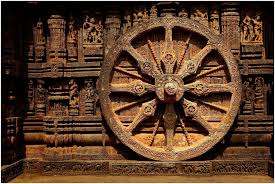
|
Konark Sun Temple is a 13th-century CE Sun Temple at Konark in Orissa, India. It is believed that the temple was built by king Narasimha deva of Eastern Ganga Dynasty in 1255 CE. The temple complex is in the shape of a gigantic chariot, having elaborately carved stone wheels, pillars and walls. A major part of the structure is now in ruins.
The temple is a UNESCO World Heritage Site and has also featured on various list of Seven Wonders of India. The temple is 35 km from Puri and 65 km from Bhubaneswar.
|
|
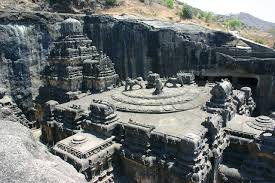
|
Ellora caves is one of the largest rock-cut monastery-temple caves complexes in the world, and a UNESCO World Heritage Site in Maharashtra, India. The site presents monuments and artwork of Buddhism, Hinduism and Jainism from the 600-1000 CE period.
Cave 16 of Ellora features the largest single monolithic rock excavation in the world, the Kailasha temple, a chariot shaped monument dedicated to Shiva. The Kailasha temple excavation also presents the gods, goddesses and mythologies found in Vaishnavism, Shaktism and relief panels summarizing the two major Hindu Epics.
|
|
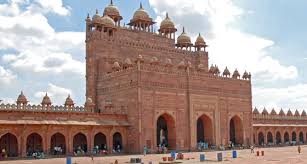
|
Fatehpur Sikri is a city in the Agra District of Uttar Pradesh, India. The city was founded in 1569 by the Mughal Emperor Akbar, and served as the capital of the Mughal Empire from 1571 to 1585, when it was abandoned. After his military victories over Chittor and Ranthambore, Akbar decided to shift his capital from Agra to a new location 23 miles (37 km) west south-west, to honor the Sufi saint Salim Chishti. Here, he commenced the construction of a planned walled city, which took the next fifteen years in planning and construction, with a series of royal palaces, harem, courts, a mosque, private quarters and other utility buildings.
He named the city Fatehabad, with Fateh, a word of Arabic origin in Persian, meaning "victorious." It was later called Fatehpur Sikri. It is at Fatehpur Sikri that the legends of Akbar and his famed courtiers, the nine jewels or Navaratnas, were born. Fatehpur Sikri is one of the best preserved examples of Mughal architecture in India.
|
|
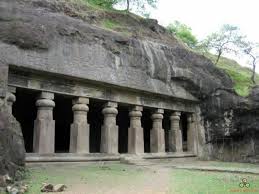
|
Elephanta Caves are a network of sculpted caves located on Elephanta Island, or Gharapuri (literally "the city of caves") in Mumbai Harbour, 10 kilometers (6.2 mi) to the east of the city of Mumbai in the Indian state of Maharashtra. The island, located on an arm of the Arabian Sea, consists of two groups of caves- the first is a large group of five Hindu caves, the second, and a smaller group of two Buddhist caves.The Hindu caves contain rock cut stone sculptures, representing the Shaiva Hindu sect, dedicated to the Lord Shiva. The caves are hewn from solid basalt rock. All the caves were also originally painted in the past, but now only traces remain.
|
|
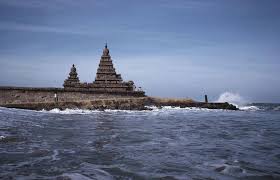
|
Mamallapuram, also known as Mahabalipuram, is a town in Kancheepuram district in the Indian state of Tamil Nadu, around 60 km south of the city of Chennai. It is an ancient historic town and was a bustling seaport during the time of Perilous (1st century CE) and Ptolemy (140 CE), from where ancient Indian traders sailed to countries of South East Asia.
By the 7th century it was a port city of the South Indian dynasty of the Pallavas. It has a group of sanctuaries carved out of rock in the 7th and 8th centuries: rathas (temples in the form of chariots), mandapas (cave sanctuaries), giant open-air rock reliefs such as the famous Descent of the Ganges, and the Shore Temple, with thousands of sculptures to the glory of Shiva.
|
|
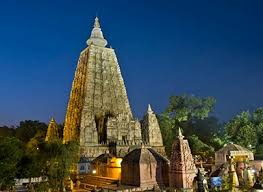
|
The Mahabodhi Temple, a UNESCO World Heritage Site, is a Buddhist temple in Bodh Gaya, marking the location where the Buddha is said to have attained enlightenment. Bodh Gaya (located in Gaya district) is located about 96 km (60 mi) from Patna, Bihar state, India.
|
|
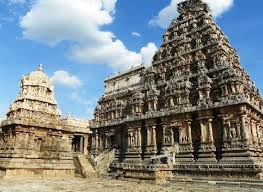
|
The Great Living Chola Temples are temples built during the Chola rule in the south of India and neighboring islands. These sites includes 3 temples of 11th and 12th century. These 3 temples are the Brihadisvara Temple at Thanjavur, the Temple of Gangaikonda Cholapuram and the Airavatesvara Temple at Darasuram. The Brihadisvara Temple was declared by UNESCO as a World Heritage Site in 1987; the Temple of Gangaikondacholisvaram and the Airavatesvara Temple at Darasuram were added as extensions to the site in 2004. The site is now known as the "Great Living Chola Temples".
|
|
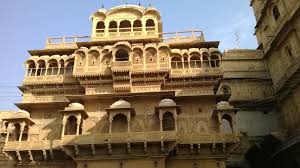
|
The Hill Forts of Rajasthan in northern India are a UNESCO World Heritage Site. They comprise:
· Chittorgarh Fort
· Kumbhalgarh Fort
· Ranthambore Fort
· Gagron Fort
· Amber Fort
· Jaisalmer Fort
The forts are mainly based in the Aravalli Range and were built between the 5th and 17th-18th centuries AD.
|
|
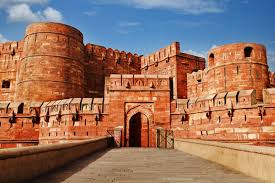
|
Agra Fort is a historical fort in the city of Agra in India. It was the main residence of the emperors of the Mughal Dynasty till 1638, when Mughal capital was shifted from Agra to Red Fort in Delhi. It is also a UNESCO World Heritage site and is about 2.5 km northwest of its more famous sister monument, the Taj Mahal. The fort can be more accurately described as a walled city.
|
|
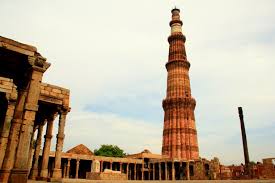
|
The Qutb complex also spelled Qutab or Qutub is an array of monuments and buildings at Mehrauli in Delhi, India. The best-known structure in the complex is the Qutb Minar, built to honor the Sufi saint Qutbuddin Bakhtiar Kaki. Its foundation was laid by Qutb-ud-din Aibak, who later became the first Sultan of Delhi of the Mamluk dynasty. The Minar was added upon by his successor Iltutmish, and much later by Firoz Shah Tughlaq, a Sultan of Delhi from the Tughlaq dynasty in 1368. The Qubbat-ul-Islam Mosque, later corrupted into Quwwat-ul Islam, stands next to the Qutb Minar. It was built on the ruins of Lal Kot Fort and Qila-Rai-Pithora (the Chauhan emperor Prithviraj Chauhan's city), whom Ghori's Afghan armies had earlier defeated and killed in the Second Battle of Tarain.
|
|
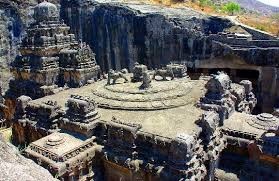
|
The Kailasha temple or Kailasanatha temple is one of the largest rock-cut ancient Hindu temples located in Ellora, Maharashtra, India. A megalith carved out of one single rock, it is considered one of the most remarkable cave temples in India because of its size, architecture and sculptural treatment.
The Kailasanatha temple (Cave 16) is one of the 34 cave temples and monasteries known collectively as the Ellora Caves. Its construction is generally attributed to the 8th century Rashtrakuta king Krishna I in 756-773 CE. The temple architecture shows traces of Pallava and Chalukya styles.
|